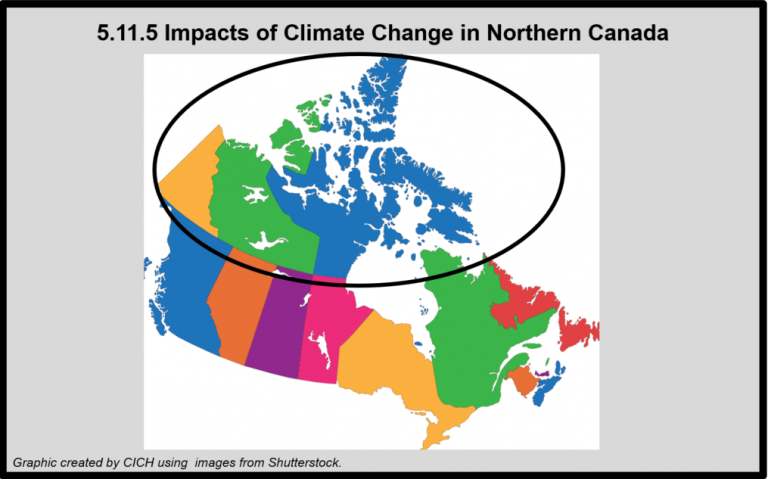Impacts of climate change in Northern Canada

The average surface air temperature over Canada has warmed by about 1.7°C between 1948 and 2012 – that is twice the global average. The rate of warming in Northern Canada has been about 2½ times the global average since the late 1940s.1
There have already been significant environmental changes in the North as a result of increasing temperatures. These include decreased ice thickness, melting of permafrost, coastal erosion, rising sea levels, landslides, and altered distribution and migration of wildlife.2,3
Climate change will likely lead to the spread of animal-transmitted diseases throughout the North, putting children at increased risk of disease.4 With remote health services in the North, illness, especially if widespread or epidemic, is of particular concern.
1Government of Canada. (2013). Canada’s Sixth National Report on Climate Change: 2014. https://ec.gc.ca/cc/16153A64-BDA4-4DBB-A514-B159C5149B55/6458_EC_ID1180-MainBook_high_min%20FINAL-s.pdf-accessed March 5, 2017.
2Berry, P., Clarke, K., Fleury, M.D. and Parker, S. (2014): Human Health; In Canada in a Changing Climate: Sector Perspectives on Impacts and Adaptation, (ed.) F.J. Warren and D.S. Lemmen; Government of Canada, Ottawa, ON, p. 191-232. https://www.nrcan.gc.ca/sites/www.nrcan.gc.ca/files/earthsciences/pdf/assess/2014/pdf/Chapter7-Human-Health_Eng.pdf-accessed July 24, 2017.
3Furgal C. Health impacts of climate change in Canada’s north. Rep. No.: H128–1/08-528E. Ottawa, ON: Health Canada; 2008.
4Lemmen, D.S., Warren, F.J., Lacroix, J., & Bush, E. (2008). From Impacts to Adaptation: Canada in a Changing Climate 2007. Government of Canada, Ottawa, ON, 448. https://www.nrcan.gc.ca/sites/www.nrcan.gc.ca/files/earthsciences/pdf/assess/2007/pdf/synth_e.pdf-accessed July 24, 2017.
